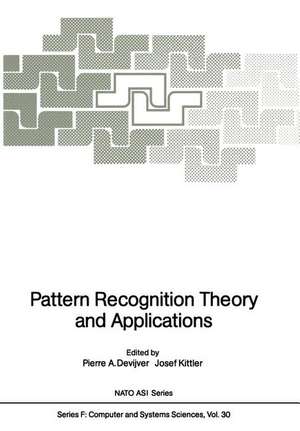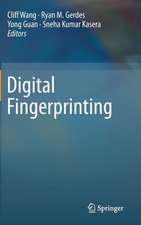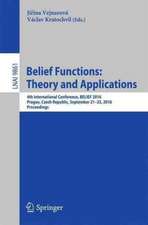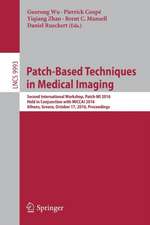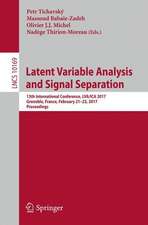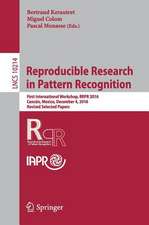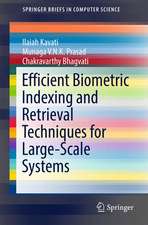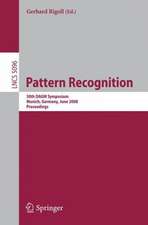Pattern Recognition Theory and Applications: NATO ASI Subseries F:, cartea 30
Editat de Pierre A. Devijver, Josef Kittleren Limba Engleză Paperback – mar 2012
Din seria NATO ASI Subseries F:
- 20%
 Preț: 650.27 lei
Preț: 650.27 lei - 20%
 Preț: 668.55 lei
Preț: 668.55 lei - 20%
 Preț: 992.44 lei
Preț: 992.44 lei - 18%
 Preț: 1239.19 lei
Preț: 1239.19 lei - 20%
 Preț: 1922.81 lei
Preț: 1922.81 lei - 20%
 Preț: 654.37 lei
Preț: 654.37 lei - 18%
 Preț: 1234.00 lei
Preț: 1234.00 lei - 20%
 Preț: 709.78 lei
Preț: 709.78 lei - 20%
 Preț: 656.03 lei
Preț: 656.03 lei - 18%
 Preț: 1854.94 lei
Preț: 1854.94 lei - 20%
 Preț: 374.97 lei
Preț: 374.97 lei - 20%
 Preț: 991.94 lei
Preț: 991.94 lei - 20%
 Preț: 671.02 lei
Preț: 671.02 lei - 20%
 Preț: 1925.96 lei
Preț: 1925.96 lei - 20%
 Preț: 994.73 lei
Preț: 994.73 lei -
 Preț: 389.49 lei
Preț: 389.49 lei - 20%
 Preț: 657.99 lei
Preț: 657.99 lei - 20%
 Preț: 655.20 lei
Preț: 655.20 lei - 18%
 Preț: 1225.31 lei
Preț: 1225.31 lei - 18%
 Preț: 952.09 lei
Preț: 952.09 lei - 20%
 Preț: 332.06 lei
Preț: 332.06 lei - 20%
 Preț: 1284.47 lei
Preț: 1284.47 lei - 20%
 Preț: 644.81 lei
Preț: 644.81 lei -
 Preț: 395.85 lei
Preț: 395.85 lei - 18%
 Preț: 1221.07 lei
Preț: 1221.07 lei - 15%
 Preț: 643.34 lei
Preț: 643.34 lei - 20%
 Preț: 645.47 lei
Preț: 645.47 lei - 20%
 Preț: 1282.98 lei
Preț: 1282.98 lei - 20%
 Preț: 656.36 lei
Preț: 656.36 lei - 20%
 Preț: 1283.31 lei
Preț: 1283.31 lei - 20%
 Preț: 1924.15 lei
Preț: 1924.15 lei - 20%
 Preț: 362.24 lei
Preț: 362.24 lei
Preț: 662.48 lei
Preț vechi: 828.09 lei
-20% Nou
Puncte Express: 994
Preț estimativ în valută:
126.77€ • 135.56$ • 105.69£
126.77€ • 135.56$ • 105.69£
Carte tipărită la comandă
Livrare economică 17 aprilie-01 mai
Preluare comenzi: 021 569.72.76
Specificații
ISBN-13: 9783642830716
ISBN-10: 3642830714
Pagini: 564
Ilustrații: XI, 543 p.
Dimensiuni: 170 x 244 x 30 mm
Greutate: 0.89 kg
Ediția:Softcover reprint of the original 1st ed. 1987
Editura: Springer Berlin, Heidelberg
Colecția Springer
Seria NATO ASI Subseries F:
Locul publicării:Berlin, Heidelberg, Germany
ISBN-10: 3642830714
Pagini: 564
Ilustrații: XI, 543 p.
Dimensiuni: 170 x 244 x 30 mm
Greutate: 0.89 kg
Ediția:Softcover reprint of the original 1st ed. 1987
Editura: Springer Berlin, Heidelberg
Colecția Springer
Seria NATO ASI Subseries F:
Locul publicării:Berlin, Heidelberg, Germany
Public țintă
ResearchCuprins
Statistical Methods and Clustering Techniques.- 1. Advances in statistical pattern recognition.- 2. Texture subspaces.- 3. Automatic selection of a discrimination rule based upon minimization of the empirical risk.- 4. Linear models in spatial discriminant analysis.- 5. Non supervised classification tools adapted to supervised classification.- 6. The bootstrap approach to clustering.- 7. On the distribution equivalence in cluster analysis.- 8. Spatial point processes and clustering tendency in exploratory data analysis.- Probabilistic Relaxation Techniques.- 9. Relaxation labelling.- 10. Optimisation algorithms in probabilistic relaxation labelling.- 11. Feature point matching using temporal smoothness in velocity.- 12. Multiresolutional cluster segmentation using spatial context.- From Markovian to Connectionist Models.- 13. Learning the parameters of a hidden Markov random field image model: A simple example.- 14. Locating texture and object boundaries.- 15. Simulated annealing: A pedestrian review of the theory and some applications.- 16. The detection of geological fault lines in radar images.- 17. Speech recognition experiment with 10,000 words dictionary.- 18. Adaptive networks and speech pattern processing.- 19. Energy methods in connectionist modelling.- 20. Learning and associative memory.- 21. Network representations and match filters for invariant object recognition.- Graph Theory And Geometry.- 22. Problems and possible solutions in the analysis of sparse images.- 23. Stochastic geometry and perception.- 24. Computational geometry: Recent results relevant to pattern recognition.- Structural Methods.- 25. Structural methods in pattern analysis.- 26. Structural pattern recognition: A random graph approach.- 27. Inexact graph matching used in machine vision.- 28. Development of an incremental graph matching device.- Hybrid Methods And Fuzzy Sets.- 29. Hybrid methods in pattern recognition.- 30. Fuzzy sets in pattern recognition.- Knowledge-Based Recognition Techniques.- 31. Classification problem solving: A tutorial from an AI perspective.- 32. On the structure of parallel adaptive search.- 33. Three dimensional organ recognition by tomographic image analysis.- 34. Knowledge-based computer recognition of speech.- 35. Modelling (sub)string-Iength based constraints through a grammatical inference method.- Machine Vision And Image Processing.- 36. Intrinsic characteristics as the interface between CAD and machine vision systems.- 37. The tensor differential scale space representation.- 38. The application of image tensors and a new decomposition.- 39. Image understanding strategies: Application to electron microscopy.- 40. A diffusion-based description of shape.- 41. Statistical evaluation of computer extracted blood cell features for screening populations to detect leukemias.- 42. Tissue image segmentation with multicolor, multifocal algorithms.- 43. Methods for computer analysis and comparison of two-dimensional protein patterns obtained by electrophoresis.- List Of Participants.
